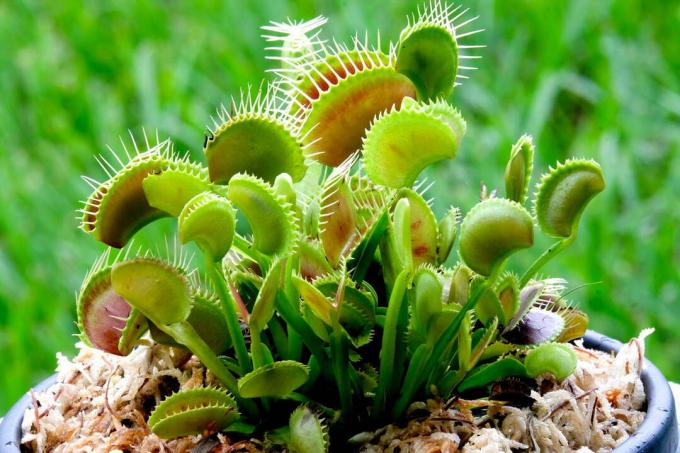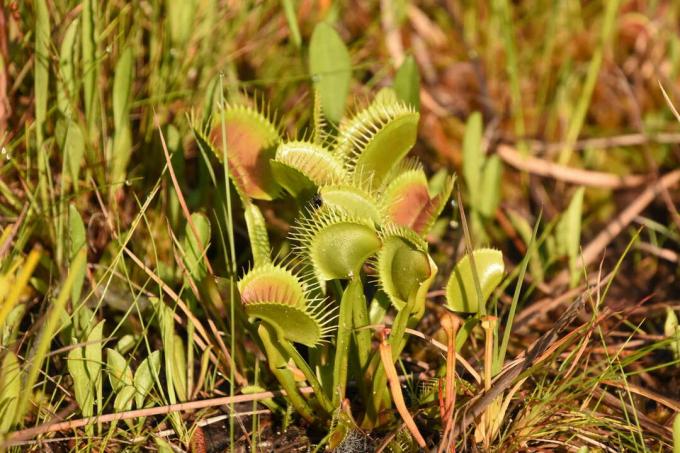Caring for the Venus flytrap is just as special as its diet. We have summarized everything you need to know about fly trap care.

the Venus Flytrap (Dionaea muscipula) places some special demands on their care and maintenance. In many details it even differs significantly from the requirements of most garden and indoor plants. We have summarized the most important facts and explain how you can successfully keep the carnivorous plant.
contents
- Maintaining Venus Flytrap: What To Look For?
- Holding Venus Flytrap: The Right Location
- The right substrate for the Venus flytrap
- Water the Venus flytrap properly
- Feed the Venus Flytrap
- Repot the Venus flytrap
- Maintain Venus Flytrap in winter
Maintaining Venus Flytrap: What To Look For?
As an exotic species, it is hardly surprising that the Venus flytrap differs significantly from other conventional indoor and garden plants in terms of its maintenance requirements. The supply of nutrients from animal prey alone is a special feature and a unique selling point. We will briefly explain what you should look out for so that your Venus flytrap thrives splendidly.
Holding Venus Flytrap: The Right Location
The Venus flytrap likes it sunny. Direct sunlight is important so that the catch leaves open wide. The plant thrives best in the room on the windowsill - if the climate is mild and even, it can move outside in summer. The flytrap places additional demands on the humidity: ideally, this should be between 50 and 60 percent. You should also protect your Venus flytrap from drafts, because it doesn't like that at all.

The right substrate for the Venus flytrap
The basis for the successful care of the Venus flytrap always lies in the choice of the right substrate. The plant thrives best on special Carnivore soils, such as the Floragard special soil for carnivorous plants. This has to do with its origin: As a bog plant, the Venus flytrap needs a soil with an acidic pH value and a low concentration of nutrients. In addition, your substrate should support a balanced water balance with good water uptake and release. Only carnivore soil can optimally meet these requirements.
Water the Venus flytrap properly
The Venus flytrap stands in its natural environment in the open field and is in contact with constantly moist soil. Even when kept as a potted plant, this fact must be simulated by regular watering. It is important that the surface of the substrate never dries out. In contrast to many other potted plants, the Venus flytrap can withstand short periods of waterlogging without any problems. That is why you can calmly place them on a trivet with water to reduce the frequency of watering a little. Another peculiarity is their intolerance to "hard" water with a high proportion of ions. It is therefore best to use filtered rainwater or distilled water mixed with ten percent tap water to water your Venus flytrap.
A detailed guide to the right one Pouring the Venus Flytrap You will find here.
Feed the Venus Flytrap
Basically, you wouldn't have to feed your Venus flytrap as it would absorb enough nutrients through insects' digestions even without your caring affection. However, if it is done correctly, feeding cannot do any harm. The most important thing about feeding is that the prey is still alive when it is placed in the trap. The stimulus that is triggered by the movement of the insect must last for a long time, otherwise the secretion of the digestive enzymes does not start. The second aspect is the size of the prey. The rule of thumb is that the prey should be one-third the length of the catch leaves for effective digestion to take place.
More detailed information about the Feeding the Venus Flytrap You will find here.

Repot the Venus flytrap
You should repot your Venus flytrap at least once a year. You can tell when the time is right when the above-ground plant material protrudes from the side of the pot. A fully rooted pot also indicates that it is time to repot the plant. Prepare a new, larger planter for repotting and fill it with a suitable plant substrate.
A detailed guide to the Repotting the Venus Flytrap can be found in our special article.
Maintain Venus Flytrap in winter
The Venus flytrap is very frugal and accordingly doesn't ask that much of you. However, she does not want to do without her hibernation. The Venus flytrap sends the unmistakable signs of moving to winter quarters: the newly formed trapping leaves get smaller and smaller and no longer form the characteristic red inside until they finally completely close stay. Once you spot these signs, it's time to move your plant to a suitable place to hibernate. Unheated stairwells or basements with large windows are ideal. The temperature should be permanently between 5 and 10 ° C. The lower the temperature, the lower the light irradiation should be.

Note: The Venus flytrap is already very frugal when it comes to its nutritional needs. Even in summer it does not need any additional fertilization under normal circumstances and gets its nutrients by digesting the prey. Therefore, under no circumstances should you fertilize in winter to avoid toxic damage from over-fertilization.



